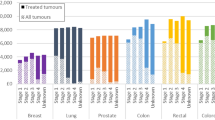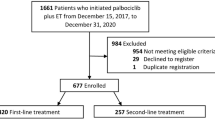Abstract
Introduction
This study aimed to evaluate the cost-effectiveness of cisplatin plus gemcitabine vs. paclitaxel plus gemcitabine as a first-line treatment for metastatic triple-negative breast cancer in China.
Methods
The Markov model and partitioned survival (PS) model were used, and the study included three health states over the period of a lifetime. Transition probabilities and safety data were derived from the CBCSG006 trial (cisplatin plus gemcitabine vs. paclitaxel plus gemcitabine in patients who had acquired metastatic triple-negative breast cancer). Cost and utility values were derived from previous studies, the Chinese Drug Bidding Database, and healthcare documents. Sensitivity analyses were performed to observe model stability.
Results
In the Markov model, compared with paclitaxel plus gemcitabine, cisplatin plus gemcitabine yielded an additional 0.15 QALYs, with an incremental cost of 1976.33 USD. The incremental cost-utility ratio (ICUR) was 12,826.98 USD/QALY (quality-adjusted life year). In the PS model, cisplatin plus gemcitabine yielded an additional 0.17 QALYs with an incremental cost of 2384.63 USD; the incremental cost-utility ratio (ICUR) was 13,867.7 USD/QALY. In the first scenario analysis, in which the 3-year time horizon was used in both arms, the total QALYs in the cisplatin plus gemcitabine group were larger and the costs were lower, indicating that cisplatin plus gemcitabine was superior to paclitaxel plus gemcitabine. In the second scenario, in which the progression-free (PF) utility (during chemotherapy) was 0.76, the PF utility was 0.96, and the post-progression (PP) utility was 0.55, the result obtained with the Markov model showed that the ICUR was 11,063.68 USD/QALY. In the probabilistic sensitivity analysis (PSA) on the Markov model, the probabilities that cisplatin plus gemcitabine would be cost-effective were 48.94–78.72% if the willingness-to-pay threshold was 9776.8 to 29,330.4 USD/QALY.
Conclusions
The findings of the present analysis suggest that cisplatin plus gemcitabine might be much more cost-effective than paclitaxel plus gemcitabine in patients receiving first-line treatment for metastatic triple-negative breast cancer in China.






Similar content being viewed by others
References
Chen W, Zheng R, Baade PD, et al. Cancer statistics in China, 2015. CA Cancer J Clin. 2016;66(2):115–32.
Bray F, Ferlay J, Soerjomataram I, Siegel RL, Torre LA, Jemal A. Global cancer statistics 2018: GLOBOCAN estimates of incidence and mortality worldwide for 36 cancers in 185 countries. CA Cancer J Clin. 2018;68(6):394–424.
Foulkes WD, Smith IE, Reis-Filho JS. Triple-negative breast cancer. N Engl J Med. 2010;363:1938–48.
Li C-Y, Zhang S, Zhang X-B, Wang P, Hou G-F, Zhang J. Clinicopathological and prognostic characteristics of triple-negative breast cancer (TNBC) in Chinese patients: a retrospective study. Asian Pac J Cancer Prev. 2013;14:3779–844.
Li CI, Beaber EF, Tang M-TC, et al. Reproductive factors and risk of estrogen receptor positive, triple-negative, and HER2-neu overexpressing breast cancer among women 20–44 years of age. Breast Cancer Res Treat. 2013;137(2):579–87.
Zhang L, Hao C, Dong G, Tong Z. Analysis of clinical features and outcome of 356 triple-negative breast cancer patients in China. Breast Care. 2012;7(1):13–7.
Kassam F, Enright K, Dent R, et al. Survival outcomes for patients with metastatic triple-negative breast cancer: implications for clinical practice and trial design. Clin Breast Cancer. 2009;9(1):29–33.
Dent R, Trudeau M, Pritchard KI, et al. Triple-negative breast cancer: clinical features and patterns of recurrence. Clin Cancer Res. 2007;13(15):4429–34.
Clark O, Botrel TEA, Paladini L, Ferreira MB. Targeted therapy in triple-negative metastatic breast cancer: a systematic review and meta-analysis. Core Evid. 2014;9:1.
Ma CX, Ellis MJC, Petroni GR, et al. A phase II study of UCN-01 in combination with irinotecan in patients with metastatic triple negative breast cancer. Breast Cancer Res Treat. 2012;137(2):483–92.
China NH. Chinese guidelines for diagnosis and treatment of breast cancer 2018 (English version). Chin J Cancer Res. 2019;31(2):259.
Association CAC. Guidelines for breast cancer diagnosis and treatment by the Chinese anti cancer association (2019 edition). China Oncol. 2019;29(8):642–43.
Hurley J, Reis IM, Rodgers SE, et al. The use of neoadjuvant platinum-based chemotherapy in locally advanced breast cancer that is triple negative: retrospective analysis of 144 patients. Breast Cancer Res Treat. 2013;138(3):783–94.
Isakoff SJ, Goss PE, Mayer EL, et al. TBCRC009: A multicenter phase II study of cisplatin or carboplatin for metastatic triple-negative breast cancer and evaluation of p63/p73 as a biomarker of response. J Clin Oncol. 2011;29(15_suppl):1025.
Hu X-C, Zhang J, Xu B-H, et al. Cisplatin plus gemcitabine versus paclitaxel plus gemcitabine as first-line therapy for metastatic triple-negative breast cancer (CBCSG006): a randomised, open-label, multicentre, phase 3 trial. Lancet Oncol. 2015;16(4):436–46.
Cheng TF, Wang JD, Uen WC. Cost-utility analysis of adjuvant goserelin (Zoladex) and adjuvant chemotherapy in premenopausal women with breast cancer. BMC Cancer. 2012;12(1):1–9.
Wu B, Ye M, Chen H, Shen JF. Costs of trastuzumab in combination with chemotherapy for HER2-positive advanced gastric or gastroesophageal junction cancer: an economic evaluation in the Chinese context. Clin Ther. 2012;34(2):468–79.
Liubao P, Xiaomin W, Chongqing T, et al. Cost-effectiveness analysis of adjuvant therapy for operable breast cancer from a Chinese perspective. Pharmacoeconomics. 2012;27(10):873–86.
Ding H, Fang L, Xin W, Tong Y, Zhou Q, Huang P. Cost-effectiveness analysis of fulvestrant versus anastrozole as first-line treatment for hormone receptor-positive advanced breast cancer. Eur J Cancer Care. 2017;26(6):e12733.
Glasziou P, Simes R, Gelber R. Quality adjusted survival analysis. Stat Med. 1990;9(11):1259–76.
Liu G, Hu S, Wu J, Wu J, Yang L, Li H. China guidelines for pharmacoeconomic evaluations, China. J Pharmaceut Econ. 2011;3:1–48.
Karlsson G, Johannesson M. The decision rules of cost-effectiveness analysis. Pharmacoeconomics. 2012;9(2):113–20.
Kuk D, Varadhan R. Model selection in competing risks regression. Stat Med. 2013;32(18):3077–88.
Zhang J, Wang Z, Hu X, et al. Cisplatin and gemcitabine as the first line therapy in metastatic triple negative breast cancer. Int J Cancer 2015;136(1):204-11.
Wanxia L, Chengcheng L, Yu N. The observation of adverse reactions about paclitaxel on joint and muscle pain and observation indomethacin suppository treatment the effect of pain. Anhui Med J. 2013;7:16.
Lu S, Ye M, Ding L, Tan F, Fu J, Wu B. Cost-effectiveness of gefitinib, icotinib, and pemetrexed-based chemotherapy as first-line treatments for advanced non-small cell lung cancer in China. Oncotarget. 2017;8(6):9996.
Khokher S, Qureshi MU, Chaudhry NA. Comparison of WHO and RECIST criteria for evaluation of clinical response to chemotherapy in patients with advanced breast cancer. Asian Pac J Cancer Prev. 2012;13(7):3213–8.
Beauchemin C, Letarte N, Mathurin K, Yelle L, Lachaine J. A global economic model to assess the cost-effectiveness of new treatments for advanced breast cancer in Canada. J Med Econ. 2016;19(6):619–29.
Briggs A, Sculpher M, Claxton K. Decision modelling for health economic evaluation. Oxford: Oxford University Press; 2006.
Beauchemin C, Letarte N, Mathurin K, Yelle L, Lachaine J. A global economic model to assess the cost-effectiveness of new treatments for advanced breast cancer in Canada. J Med Econ. 2016;19:619–29.
Agiro A, Ma Q, Acheson AK, et al. Risk of neutropenia-related hospitalization in patients who received colony-stimulating factors with chemotherapy for breast cancer. J Clin Oncol. 2016;34(32):3872–9.
Acknowledgements
Funding
No funding or sponsorship was received for this study or publication of this article. The Rapid Service Fee was funded by the authors.
Authorship
All named authors meet the International Committee of Medical Journal Editors (ICMJE) criteria for authorship for this article, take responsibility for the integrity of the work as a whole, and have given their approval for this version to be published.
Authorship Contributions
Mingjun Rui was mainly responsible for designing the study, constructing the model, collecting and interpreting the data. Fenghao Shi was mainly responsible for constructing the model. Ye Shang was mainly responsible for searching the literature and writing the manuscript. Rui Meng was mainly responsible for collecting the data. Hongchao Li was mainly responsible for designing the study, revising the manuscript, and reviewing the manuscript. All the authors made the decision to submit the manuscript for publication.
Disclosures
Mingjun Rui, Fenghao Shi, Ye Shang, Rui Meng, Hongchao Li have nothing to disclose.
Compliance with Ethics Guidelines
This article is based on previously conducted studies and does not contain any studies with human participants or animals performed by any of the authors.
Data Availability
All data generated or analyzed during this study are included in this published article/as supplementary information files.
Author information
Authors and Affiliations
Corresponding author
Additional information
Digital Features
To view digital features for this article go to https://doi.org/10.6084/m9.figshare.12497030.
Electronic supplementary material
Below is the link to the electronic supplementary material.
Rights and permissions
About this article
Cite this article
Rui, M., Shi, F., Shang, Y. et al. Economic Evaluation of Cisplatin Plus Gemcitabine Versus Paclitaxel Plus Gemcitabine for the Treatment of First-Line Advanced Metastatic Triple-Negative Breast Cancer in China: Using Markov Model and Partitioned Survival Model. Adv Ther 37, 3761–3774 (2020). https://doi.org/10.1007/s12325-020-01418-7
Received:
Published:
Issue Date:
DOI: https://doi.org/10.1007/s12325-020-01418-7




